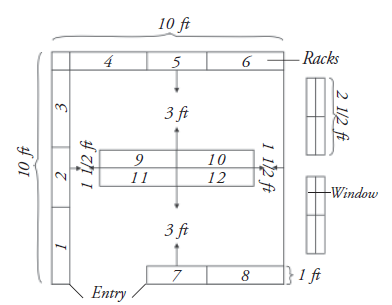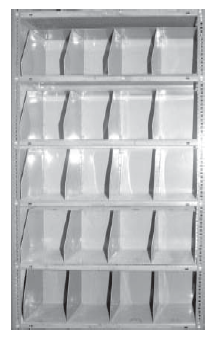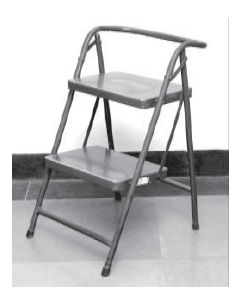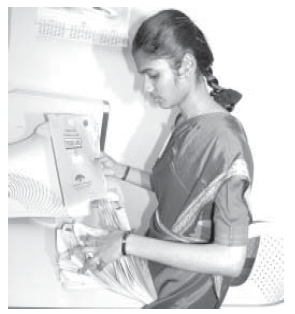Medical Records Department - Planning, Job and Function
The medical records department (MRD) must be organised and managed upon the concept that it exists for the benefit of the patients. The medical record department benefits the patient by being responsible for the completeness, accuracy and availability of the medical records at all times. Organising the work of the medical record department in order to attain the planned objectives should be done on the basis of the departments functions. The functions of the department are the processing of outpatient and inpatient records, retrieval, record storage, disease and procedure wise coding & indexing. In a smaller department which may have only a few workers, it is better for all the staff to be familiar with all aspects of the medical record department, so that the department functions smoothly.
A. Planning the work environment
Part of the planning function is providing medical records assistant with proper working environment. This includes planning for office space and location, office furniture and equipment, and spatial conditioning factors such as good lighting arrangements and color.
Departmental layout
Departmental layout: Proper layout of the medical record department adds to its efficiency and attractiveness (Fig.3.1). The key consideration in layout is workflow i.e.: the flow of record from desk to desk. Desks should be arranged so that, as far as possible, records move in straight lines and only a short distance at a time.
Departmental coloring: The proper use of color is another important consideration in office design. Effective use of color not only gives a good and bright appearance of an office, but also improves working conditions. Psychologically color can affect human emotions, senses, and thought processes, as well as individual’s ability to relax. White color will have a favorable psychological effect; others a negative effect. White color gives a lift; others can either hasten or depress mental action.

Departmental lighting: Lighting is another environmental factor, which cannot be over looked. Light sources on the ceiling can usually provide enough light for the entire office area at a prescribed level of illumination.
Location requirements
The medical record department is in constant communication with the registration departments of the out-patient and in-patient care units. Every day, many doctors visit the medical records department for completion of medical records or for records reference. The medical records department must be located in an area near the new and review registration counter and admitting and discharge office.
If the medical records department is not staffed 24 hours a day, it should be located within easy walking distance from the admitting or out-patient area to ensure hospital staffs are able to retrieve medical records on an emergency basis. Security surveillance for safeguard of medical records information and equipment when the department is closed should also be considered.
Space requirement
Space allocation should be determined by the departmental services to be provided, the equipment and computer systems to be used and the daily workload to be handled. Although services vary somewhat from hospital to hospital, services and tasks to be considered when allocating space include record filing cabins, coding and indexing desk, medical records sorting and arranging desk, outpatient registration area, and admitting and discharge office.
The medical record service requires adequate space, which is generally not available and presents a universal problem. Therefore, the medical records technician should review space requirements frequently to overcome the highly common filing problems in medical records department.
The medical records technician should anticipate in advance the growth of MRD and make arrangements for the future requirements and to procure the required space.
Equipment requirement
Open-shelf filing units are the most commonly used storage system for medical records. They are less expensive. Medical records assistant can file or retrieve records faster. Most importantly open shelves are space savers, accommodates more records in a given floor area. Open-shelf filing equipment may consists of 7 or 10 shelves with a height of 9 to 10 ½ feet depending upon the NO. of shelves (Fig.3.2). 7 open shelves having 3 feet long and 1 feet width each with dividers can house an average of 750 outpatient records in one compartment, thus housing 5250 records in a single open-shelf filing unit. If a unit-numbering system is used, adequate shelf space must be provided for growth of records as a result of readmission and repeat clinic visits.
A review of records from the past several years is the best source of information for working estimates of the amount of space required. One approach is to tabulate the average number of sheets per medical record of repeat clinic visit and discharged patient over two or three months. This can be achieved by counting the sheets per current episode of care and the sheets for previous episodes of inpatient or outpatient care. This tabulation indicates the size of an average medical record for the hospital.

Record dividers between files
Record dividers should be placed throughout the files to speed up the retrieval and filing process and finding of records. The number of dividers needed depends upon the thickness of the majority of the medical records in the shelves. For medical records of medium thickness, a divider for every hundred and fifty records is adequate. When purchasing dividers, durability and quality should be the primary concern. To determine the total number of dividers needed, the following formula may be used:
| Total number of records = | Total number of dividers |
| | |
| Number of records between dividers |
If the total number of records is not known, an estimate may be made by multiplying the filing inches by the average number of records per inch. Several shelves of records should be counted to determine the average number of records per inch. Storage and retention of medical records should be done in the most efficient manner for retrieval of requested records in a health care facility. The medical record file area may either be centralised or decentralised.
Climbing devices
Open shelf filing unit is designed to reach the maximum height of medical records filing room in order to save the space available. When medical records are placed at more than the height of 5 feet or 6 feet, it may be difficult to retrieve them. Hence, hospitals use various types of climbing devices to reach the medical records kept at a height of up to 8 or 9 feet.

An aluminum ladder with rubber bush at the bottom of the leg or a step type ladder will be of greater use to the retriever to file or retrieve the records easily. Aluminum ladder will be less in weight and easy to carry inside the medical records room. The rubber bush avoids ladder from slipping down.
The step type steel ladder will be easy to climb exclusively for female (Fig.3.3). Thus, climbing device will be much more helpful for the filing assistants to place or to retrieve medical records much quickly avoiding unnecessary accidents.
Organisational chart
It is important that each employee knows the limits of his authority and responsibility, and an organisational chart is a good means of informing others about such relationships. An organisational chart indicating the functions and lines of authority should be clearly established (Fig.3.4). This will ensure there is no ambiguity in understanding either the line of authority or the duties and responsibilities of staff members. In a medical records department procedures may be written for every job performed.
Job description
Written procedure manual for job description provides a valuable tool for two reasons.
- First, it provides an employee who regularly performs a procedure with an exact picture of what she is expected to do
- Secondly, it is an invaluable aid in cross-training regular employees and in training new employees
It is helpful for a medical record Technician to go through a procedure with the employee at least once before the employee attempts to follow it by herself. It is also necessary that job description be explicitly written for every staff .When a procedure is reviewed, the job description for employees who carry out that procedure should also be reviewed. Job description for an employee spells out the qualifications needed to perform a job in a satisfactory manner.

Job description for a medical records assistant
Job title: Medical records assistant
Routine tasks
With thorough knowledge of the work involved and with occasional supervision of the medical records Technician, uses initiative and independent judgment in the departmental activities.
Prime job
- To ensure smooth functioning in the New and Revisit Registration area, Admission and Discharge area and medical records department
- To ensure quick disposal of patients from the Registration, Admission and discharge areas
- To meet the training requirements of the new medical records staff and trainees
- To ensure that medical records codification is updated by clinic wise and surgical wise everyday
- To prepare monthly and yearly Statistical reports
Role and responsibility
- To update codification of medical records by diagnosis wise and surgery wise everyday
- To prepare statistical report according to surgery wise and doctor’s wise everyday
- To ensure that medical records are processed serially and filed everyday
- To generate all statistical data on daily, monthly and yearly basis to submit to Management authorities
- To take regular classes for the medical record trainees based on the medical records book
- To procure and keep all forms and stationary needed for every week from stores
- To solve problems and grievances (if any) of patients and to ensure patient satisfaction
- To ensure that medical records are inactivated and disposed of based on the inactivating and disposing policy of the hospital
- To ensure that adequate space and racks are available to keep medical records every month
- To ensure that missing medical records or wrongly filed medical records are searched and taken out
Working relations with other department
- To co-operate with accounts section on day to day handling of registration, Admission and lab investigation cash and settlement of accounts
- To coordinate with computer section in generation of any statistical reports required by the management and in case of any computer problems
- To coordinate with the doctor’s secretary in issuing medical records to doctors for project study and seminars
Functions of the medical records department
Training of new staff
Every new staff must be clearly informed in writing of hospital and departmental policies, rules and procedures. A supervisor cannot hold a staff accountable for his / her actions unless the staff has a clear understanding of his responsibilities.
Provide on Job Orientation and Training
All staff are entitled to thorough training for the job to which they are assigned. An intensive training of three to four weeks should be given to all new departmental staff before they are independently put to work.
The new staff member should first be introduced to all the personnel of the department and later to the hospital’s important units, which maintain a close relationship with the medical record department. In the initial training stage, staff members should be placed under an experienced medical records supervisor who in turn must impart “on job training” and instruct the new staff in observing the correct policies and procedures.
Evaluate performance
Every staff wants to know where he stands with his/her supervisor.
Evaluations of performance should take place on a regular basis. Point out to the staff his/her strengths and weakness.
The medical records technician should assist the staff in correcting poor performance. The medical records technician and the supervisor should share in a process of goal setting. This provides a staff with direction for development and creates job satisfaction and improves his/her self-confidence. Verbally scolding a staff in presence of others is not acceptable.
Supervisors should strive to maintain two way communications with staff, and staffs should be encouraged to make suggestions.Supervisors in turn should be sympathetic when listening to staff’s problems. Finally, a supervisor will at times have to give priority to get a job done by the staff or to untie a problem.
Main Functions
The main functions of medical records department are
Out-patient service
- Registration of new and revisit patients
- Guiding patient to units and specialties
- Coding of out-patient and in-patient medical records
- Collecting, processing, sorting and arranging of medical records
In-patient service
- Admitting patients
- Discharging patients
Out-patient service
The purpose of the out-patient service area is to register new and revisit patients and direct them to the concerned units or specialties for consultation and treatment.
New and revisit registration
This section functions throughout the week from Monday to Saturday. The medical records assistant employed in the new registration area performs the following function:
I. Procedure for New Registration
- Before registering the new patients the medical records assistant checks for the sociological data form, outpatient records, and plastic pouch to keep ID card, staplers and bell pin in the new registration counter.
- The medical records assistant checks the system and other tools to assure they are working properly.
- The New Registration counter starts functioning in the morning.
- The sociological form filled up by the patient contains the patient’s name, age, sex and relatives name, address of the patient with city, Patient’s telephone number, mobile number and fax number.
- The filled up sociological data form is collected at the new registration counter and checked for any correction, omissions and additions.
- The medical records assistant then enters the data in the system.
- The amount that may be due for the new registration is collected from the patient.
- The currency notes are then checked in the fake note identifier machine to confirm good notes.
- The medical record assistant checks with the patient for any referral letters from outside doctors.
- The data is then printed in the outpatient main card.
- The identification card along with the receipt is given to the patient bearing his medical records number.
- The patient is well informed about the likely duration of his consultation and treatment with the doctor.
- The patient is then taken to the doctor along with his outpatient record for consultation.
II. Procedure for Revisit Registration
- Patients visiting the hospital from the next day of their new registration are subsequently called as revisit patients.
- The medical records assistant checks the system and other tools at the counter to assure they are working properly.
- The revisit registration counter starts functioning in the morning.
- The revisit patient produces the identification card to the revisit registration counter
- The medical records assistant then enters the medical record number in the system to register the patient
- The money that is due for the revisit registration is collected from the patient
- Tracer card is prepared for record retrieval by entering the date of registration and medical records number
- The purpose of the tracer card is to help the retriever to trace the medical records when it is not found in its place
- The tracer card is then taken by the medical records assistant to retrieve the medical record
- After retrieving the medical record by M.R.Number, the tracer card is kept in place of the record
- In case if the medical record is missing, the tracer card will help to find out the location of the medical record
2. Procedure for patient guides
- During the course of training in medical records, the medical record trainees are assigned the role of the patient guides
- The role of the patient guides is to guide the patients to the concerned units from the new and revisit registration area
- After registration, the new and revisit patients waiting in the lounge are called through the public address system
- After confirming the name and city of the patients called, the patient guides will guide them to the concerned units and specialities
Processing and filing of out-patient and in-patient medical records
The main functions of this area are:
- Collection of medical records from the out-patient clinics, speciality clinics and discharge counter
- Checking for deficiencies in outpatient and inpatient records
- Coding of completed records in the system
- Sorting and serially arranging medical records
Collection and sorting out of disposed of records for filing
- The patient medical records are collected from the dispose box of each out-patient clinics, speciality clinics and discharge counter by the patient guides.
- The collected medical records are checked for deficiency in outpatient and inpatient records. The medical records are checked for any incompleteness, final diagnosis and, doctor’s signature.
- The collected medical records are sorted out according to units and speciality for coding.
- Each medical record is coded according to the diagnosis and treatment given. (The importance of coding is explained elaborately in chapter – 6 of this manual).
- The coding is done in computer software designed for this purpose.
- After coding is done, all the medical records are arranged serially in ascending order according to the medical records number(Fig.3.5).
- The medical records thus sorted out and arranged in ascending order are placed in different medical record boxes for filing.
- Each medical record box is assigned with serial numbers in a continuous sequence from 1 to 10000 and from 10001 to 20000 and so on.
- Each medical record box is allotted to a medical records assistant for filing in relevant racks.

In- patient service
The in-patient medical record services are classified into two sections. They are Admission and Discharge counter and Accident and Emergency (casualty) service.
Admission counter
This admission counter functions 24 hours a day throughout the year. Staff are posted in two shifts (morning and night) to perform the following functions.
- The patients are guided by the counselors to the admission counter after counseling is done for the type of lens and room they prefer.
- The admission counter staff collects the money for the surgery and an advance receipt is generated in the system.
- The receipt is signed by the staff and handed over to the patient.
- The inpatient record is prepared with patient name, age, sex and a rubber stamp is stamped to write the type of lens and the amount paid by the patient.
- Signature of the patient or his attendant is obtained in the operation consent form.
- A color folder is attached to hold all the relevant medical record forms of the patient. This folder denotes the speciality to which the patient is admitted.
- Patient is then taken to the ward or theatre by the nursing staff along with the case sheet for surgery.
In-patient coding assistant
- After surgery is performed in the theatre, the medical records are sent to the inpatient coding assistant.
- Each medical record is coded for the surgery performed in the theatre, which automatically updates the charges for the surgery in the system.
- If patient is supported by monitor or any other additional procedure is done during the course of the surgery, they are also charged and updated in the system.
Discharge counter
- The case sheet is received from the ward through the nursing staff to the discharge counter
- The final receipt is generated according to the number of days stay and for the surgery performed
- The final receipt along with the discharge summary is handed over to the patient
- The follow-up date of patient’s revisit is explained to the patient by the discharge counter staff
Monthly duty rosters (schedules)
For effective utilization of personnel, a monthly duty roster must be prepared. Every month the staff should be rotated from one section to another, with the exception of the specially trained and supervisory staff. The supervisory and specially trained should be rotated once every three to six months. The monthly duty schedule should include name of the staff, his or her designation, place of work, main duties and responsibilities, and the person to whom he or she should report.
Departmental meetings
There should be weekly general meeting with all departmental staff to review the day-to-day work carried out by the medical records department. Any new innovations brought for the better improvement of the department can be shared with the staff members. The problems and issues related to the staff and the department can be discussed among the staff with the medical records technician and proper solution should be evolved for the smooth functioning of the department.
Summary
The medical records department staff must be more than a skilled technician. He/She must be both a leader and an innovator in building up a well-organized, efficient department. Constant effort is necessary to keep abreast of the advances in both medicine and the technology of recording and retrieving data. Efficient organization and management of the medical record department are important factors in the accreditation of health care facilities. The health facility exists for the benefit of the patient, and its medical records department is responsible for the accuracy, safekeeping, and availability of the medical record at all times. It can discharge these responsibilities only when it is properly organized and well managed by the medical records assistant.
Key points to remember
- In organising any health facility, it must be remembered that the primary responsibility and objective is the proper care of the sick and injured.
- For effective utilization, a monthly duty roster must be prepared and the staff should be rotated from one section or unit to another, with the exception of the specially trained and supervisory staff.
- Organizstional chart indicating the functions and lines of authority should be clearly established and the job description for every staff should be clearly written.
- General weekly meetings with all departmental staff to review the day-to-day work carried out by the medical records department should be conducted.
- In the initial training stage, staff members should be posted under an experienced medical records supervisor who in turn must impart “on the job training” and instruct the new employee in observing the correct policies and procedures.
- Cooperative and responsible personnel are most important for efficient management.
Students exercise
Answer the following
- Explain the purpose of an organization chart and the use of the monthly duty roster?
- Describe the common function carried out in new and review registration area?
- Explain the major function carried out in the admission, discharge and, casualties counter.
